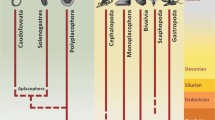Abstract
Mature calcareous corpuscles in the juvenile (stomach) worms of Trilocularia acanthiaevulgaris comprise a number of concentric lamellae interspersed with areas of flocculent material. Each lamella is composed of a pair of membranous rings to which amorphous, non-crystalline material is attached. The process of corpuscle formation is intracellular, beginning with the autophagic breakdown of the cytoplasm to produce a central vacuole within a parenchymal cell. The vacuole enlarges until only a thin layer of cytoplasm remains at the periphery and the nucleus is displaced to one end of the cell. Paired, concentrically arranged membranes are laid down beneath the peripheral cytoplasmic layer and eventually occlude the central vacuole. X-ray analysis of the corpuscles indicates the presence of calcium, phosphorus, sulphur, zinc and molybdenum, with the major peaks representing calcium, phosphorus and sulphur. Calcium appears to be bound to the lamellae rather than associated with the material between lamellae. The possible functions of the corpuscles are discussed in relation to the biology of T. acanthiaevulgaris and its developmental sequence in the dogfish gut.
Similar content being viewed by others
References
Brand T von, Mercado TI, Nylen MU, Scott DB (1960) Observations on function, composition, and structure of cestode calcareous corpuscles. Exp Parasitol 9:205–214
Brand T von, Scott DB, Nylen MU, Pugh MH (1965) Variations in the mineralogical composition of cestode calcareous corpuscles. Exp Parasitol 16:382–391
Brand T von, Nylen MU, Martin GN, Churchwell FK (1967) Composition and crystallization patterns of calcareous corpuscles of cestodes grown in different classes of hosts. J Parasitol 53:683–687
Chowdhury N, De Rycke PH (1974) Quantitative distribution of calcareous corpuscles in Hymenolepis microstoma and their significance in the biology of the cestode. Biol Jaarb 42:51–60
Chowdhury N, De Rycke PH (1976) Morphogenesis of calcareous corpuscles in Hymenolepis microstoma (Cestoda, Cyclophyllidea) during early postembryonic development. Acta Parasitol Pol 24:93–102
Chowdhury N, De Rycke PH (1977) Structure, formation, and functions of calcareous corpuscles in Hymenolepis microstoma. Z Parasitenkd 53:159–169
Chowdhury AB, Dasgupta B, Ray HN (1955a) “Kernechtrot” or nuclear fast red in the histochemical detection of calcareous corpuscles in Taenia saginata. Nature 176:701–702
Chowdhury AB, Dasgupta B, Ray HN, Bhaduri NV (1955b) Histochemical study of the calcareous corpuscle in Taenia saginata. Bull Calcutta Sch Trop Med 3:52–53
Chowdhury AB, Dasgupta B, Ray HN (1962) On the nature and the structure of the calcareous corpuscles in Taenia saginata. Parasitology 52:153–157
Desser SS (1963) Calcium accumulation in larval Echinococcus multilocularis. Can J Zool 41:1055–1059
Hamilton GIV, Fairweather I (1986) Occurrence, structure and possible function of the numerous calcareous corpuscles found in both larval and adult Hymenolepis diminuta. Proceedings of the British Society for Parasitology, Spring Meeting held at the University College of Wales, Aberystwyth, April 1986, p. 20. Parasitology 93:410
Hamilton GIV, Harriott M, Burns DT, Fairweather I (1987) Hymenolepis diminuta: chemical analysis of calcareous corpuscles. Proceedings of the British Society for Parasitology, Spring Meeting held at the University of Edinburgh, March 1987, p. 44. Parasitology (in press)
Ishii AI (1984) Fe-rich corpuscles in Diplogonoporus grandis detected using X-ray microanalysis. Z Parasitenkd 70:199–202
Kegley LM, Brown BW, Berntzen AK (1969) Mesocestoides corti: inorganic components in calcareous corpuscles. Exp Parasitol 25:85–92
Logachev ED (1951) Formation and development of calcareous bodies in tapeworms. Dokl Akad Nauk SSSR 80:693–695
Martin WE, Bils RF (1964) Trematode excretory concretions: formation and fine structure. J Parasitol 50:337–344
McCullough JS, Fairweather I (1983) A SEM study of the cestodes Trilocularia acanthiaevulgaris, Phyllobothrium squali and Gilquinia squali from the spiny dogfish. Z Parasitenkd 69:655–665
McCullough JS, Fairweather I (1984) A comparative study of Trilocularia acanthiaevulgaris Olsson 1867 (Cestoda, Tetraphyllidea) from the stomach and spiral valve of the spiny dogfish. Z Parasitenkd 70:797–807
McCullough JS, Fairweather I, Montgomery WI (1986) The seasonal occurrence of Trilocularia acanthiaevulgaris (Cestoda: Tetraphyllidea) from spiny dogfish in the Irish Sea. Parasitology 93:153–162
Nieland ML, Brand T von (1969) Electron microscopy of cestode calcareous corpuscle formation. Exp Parasitol 24:279–289
Olsson P (1867) Entozoa iakttagna hos skandinaviska hafsfiskar. I. Platyhelminthes. Lunds Univ Arsskr Ard Math o Naturv-Vetensk 3:1–59
Rambourg A, Leblond CP (1967) Electron microscope observations on the carbohydrate-rich cell coat present at the surface of cells in the rat. J Cell Biol 32:27–53
Scott DB, Nylen MU, Brand T von, Pugh MH (1962) The mineralogical composition of the calcareous corpuscles of Taenia taeniaeformis. Exp Parasitol 12:445–458
Smyth JD (1969) The physiology of cestodes. Oliver and Boyd, Edinburgh
Smyth JD, Halton DW (1983) The physiology of trematodes. Cambridge University Press, Cambridge
Timofeev VA (1964) Electron microscopic study of calcareous bodies of the plerocercoid and adult of Schistocephalus pungitii. Dokl Akad Nauk SSSR 156:1244–1247
Vonk HJ Jr (1927) Die Verdauung bei den Fischen. Z Vgl Physiol 5:445–546
Author information
Authors and Affiliations
Rights and permissions
About this article
Cite this article
McCullough, J.S., Fairweather, I. The structure, composition, formation and possible functions of calcareous corpuscles in Trilocularia acanthiaevulgaris Olsson 1867 (Cestoda, Tetraphyllidea). Parasitol Res 74, 175–182 (1987). https://doi.org/10.1007/BF00536030
Accepted:
Issue Date:
DOI: https://doi.org/10.1007/BF00536030




